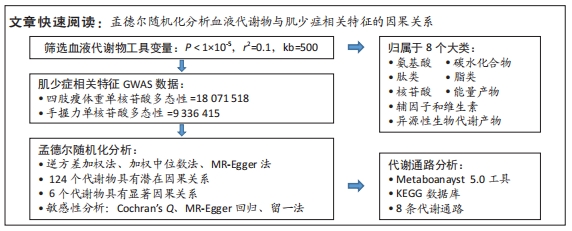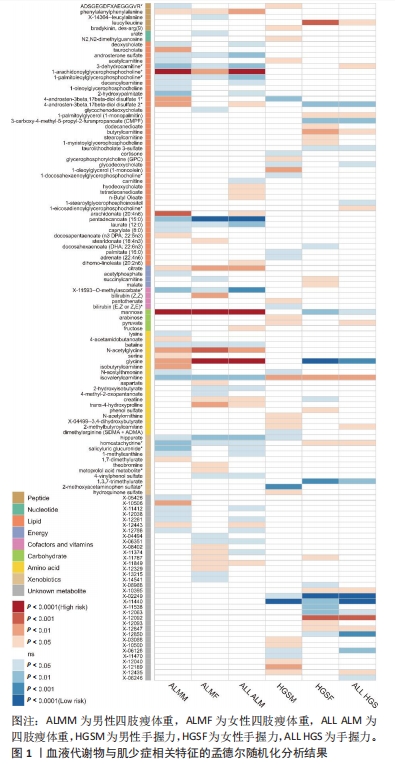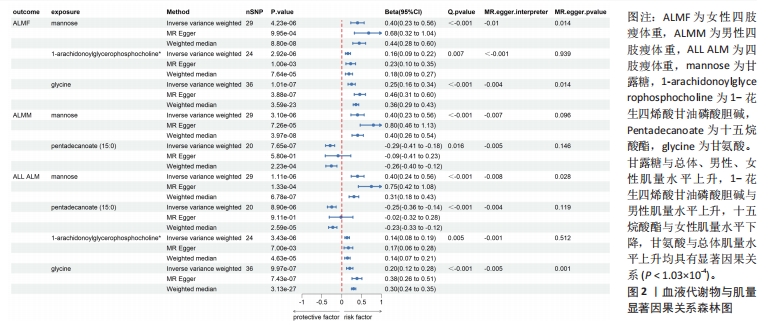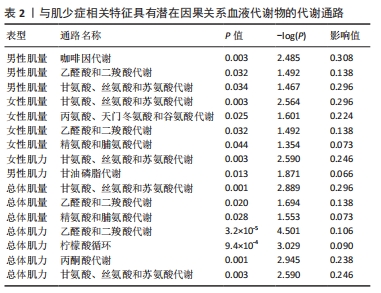[1] SAYER AA, CRUZ-JENTOFT A. Sarcopenia definition, diagnosis and treatment: consensus is growing. Age Ageing. 2022;51(10):1-5.
[2] PETERMANN-ROCHA F, BALNTZI V, GRAY SR, et al. Global prevalence of sarcopenia and severe sarcopenia: a systematic review and meta-analysis. J Cachexia Sarcopenia Muscle. 2022;13(1): 86-99.
[3] MURPHY CH, MCCARTHY SN, MCMORROW AM, et al. Prevalence and determinants of sarcopenia in community-dwelling older adults in Ireland. Aging Clin Exp Res. 2023;35(8):1651-1660.
[4] YUAN S, LARSSON SC. Epidemiology of sarcopenia: Prevalence, risk factors, and consequences. Metabolism. 2023;144:155533.
[5] SAEDI AA, DEBRUIN DA, HAYES A, et al. Lipid metabolism in sarcopenia. Bone. 2022;164: 116539.
[6] XIA Z, CHOLEWA J, ZHAO Y, et al. Targeting Inflammation and Downstream Protein Metabolism in Sarcopenia: A Brief Up-Dated Description of Concurrent Exercise and Leucine-Based Multimodal Intervention. Front Physiol. 2017;8:434.
[7] MARTÍNEZ-ARNAU FM, FONFRÍA-VIVAS R, BUIGUES C, et al. Effects of Leucine Administration in Sarcopenia: A Randomized and Placebo-controlled Clinical Trial. Nutrients. 2020;12(4):1-16.
[8] LI CW, YU K, SHYH-CHANG N, et al. Sterol metabolism and protein metabolism are differentially correlated with sarcopenia in Asian Chinese men and women. Cell Prolif. 2021;54(4):e12989.
[9] 陈天鑫,张智龙,朱瑜琪,等.恶性肿瘤与骨密度因果关系的双向两样本孟德尔随机化研究[J].现代预防医学,2023,50(18):3276-3280+3287.
[10] XIAO G, HE H, LIU L, et al. Causality of genetically determined metabolites on anxiety disorders: a two-sample Mendelian randomization study. J Transl Med. 2022;20(1):475.
[11] SHIN SY, FAUMAN EB, PETERSEN AK, et al. An atlas of genetic influences on human blood metabolites. Nat Genet. 2014;46(6):543-550.
[12] YANG J, LIU P, WANG S, et al. Causal relationship between sarcopenia and osteoarthritis: a bi-directional two-sample mendelian randomized study. Eur J Med Res. 2023;28(1):327.
[13] PEI YF, LIU YZ, YANG XL, et al. The genetic architecture of appendicular lean mass characterized by association analysis in the UK Biobank study. Commun Biol. 2020;3(1):608.
[14] JONES G, TRAJANOSKA K, SANTANASTO AJ, et al. Genome-wide meta-analysis of muscle weakness identifies 15 susceptibility loci in older men and women. Nat Commun. 2021;12(1): 654.
[15] EVANS DM, SMITH GD. Mendelian Randomization: New Applications in the Coming Age of Hypothesis-Free Causality. Annu Rev Genomics Hum Genet. 2015;16:327-350.
[16] DIDELEZ V, SHEEHAN N. Mendelian randomization as an instrumental variable approach to causal inference. Stat Methods Med Res. 2007;16(4):309-330.
[17] YU XH, CAO RR, YANG YQ, et al. Identification of causal metabolites related to multiple autoimmune diseases. Hum Mol Genet. 2022;31(4):604-613.
[18] 彭志华,潘俊曦,冯庆辉,等.两样本孟德尔随机化分析血脂与肌肉减少症的因果关系[J].中国组织工程研究,2024,28(23):3699-3703.
[19] SANDERSON E. Multivariable Mendelian Randomization and Mediation. Cold Spring Harb Perspect Med. 2021;11(2):1-13.
[20] BURGESS S, THOMPSON SG. Interpreting findings from Mendelian randomization using the MR-Egger method. Eur J Epidemiol. 2017;32(5):377-389.
[21] HARTLEY AE, POWER GM, SANDERSON E, et al. A Guide for Understanding and Designing Mendelian Randomization Studies in the Musculoskeletal Field. JBMR Plus. 2022;6(10):e10675.
[22] LU Y, PANG Z, XIA J. Comprehensive investigation of pathway enrichment methods for functional interpretation of LC-MS global metabolomics data. Brief Bioinform. 2023; 24(1):1-15.
[23] CHEN S, HE W. Metabolome-Wide Mendelian Randomization Assessing the Causal Relationship Between Blood Metabolites and Bone Mineral Density. Calcif Tissue Int. 2023;112(5):543-562.
[24] DHANALAKSHMI M, SRUTHI D, JINURAJ KR, et al. Mannose: a potential saccharide candidate in disease management. Med Chem Res. 2023;32(3):391-408.
[25] ZHANG W, CHENG H, GUI Y, et al. Mannose Treatment: A Promising Novel Strategy to Suppress Inflammation. Front Immunol. 2021;12:756920.
[26] BATES SJ, MORROW E, ZHANG AY, et al. Mannose-6-phosphate, an inhibitor of transforming growth factor-beta, improves range of motion after flexor tendon repair. J Bone Joint Surg Am. 2006;88(11):2465-2472.
[27] LI CW, YU K, SHYH-CHANG N, et al. Pathogenesis of sarcopenia and the relationship with fat mass: descriptive review. J Cachexia Sarcopenia Muscle. 2022;13(2):781-794.
[28] BAUMGARTNER C, WOLF P, BEIGLBÖCK H, et al. Potential role of skeletal muscle glycerophosphocholine in response to altered fluid balance in humans: an in vivo nuclear magnetic resonance study. Am J Physiol Endocrinol Metab. 2023;324(4):E339-E346.
[29] LI Z, LEI H, JIANG H, et al. Saturated fatty acid biomarkers and risk of cardiometabolic diseases: A meta-analysis of prospective studies. Front Nutr. 2022;9:963471.
[30] KOBAYASHI H. [Amino Acid Nutrition in the Prevention and Treatment of Sarcopenia]. Yakugaku Zasshi. 2018;138(10):1277-1283.
[31] GHELLER BJ, BLUM JE, LIM EW, et al. Extracellular serine and glycine are required for mouse and human skeletal muscle stem and progenitor cell function. Mol Metab. 2021;43:101106.
[32] STARNES JW, PARRY TL, O’NEAL SK, et al. Exercise-Induced Alterations in Skeletal Muscle, Heart, Liver, and Serum Metabolome Identified by Non-Targeted Metabolomics Analysis. Metabolites. 2017;7(3):1-14.
[33] MIKKOLA TM, SALONEN MK, KAJANTIE E, et al. Associations of Fat and Lean Body Mass with Circulating Amino Acids in Older Men and Women. J Gerontol A Biol Sci Med Sci. 2020;75(5): 885-891.
[34] BRAS H, LIABEUF S. Differential effects of spinal cord transection on glycinergic and GABAergic synaptic signaling in sub-lesional lumbar motoneurons. J Chem Neuroanat. 2021;113:101847.
[35] FALEGAN OS, VOGEL HJ, HITTEL DS, et al. High Aerobic Capacity Mitigates Changes in the Plasma Metabolomic Profile Associated with Aging. J Proteome Res. 2017;16(2):798-805.
[36] CHEN G, YE G, ZHANG X, et al. Metabolomics Reveals Protection of Resveratrol in Diet-Induced Metabolic Risk Factors in Abdominal Muscle. Cell Physiol Biochem. 2018;45(3):1136-1148.
[37] KUMAR A, KUMAR Y, SEVAK JK, et al. Metabolomic analysis of primary human skeletal muscle cells during myogenic progression. Sci Rep. 2020;10(1):11824.
[38] JIANG D, LIU C, CHEN Y, et al. Whole body vibration activates AMPK/CPT1 signaling pathway of skeletal muscle in young and aging mice based on metabolomics study. Endocr J. 2022; 69(5):585-596.
[39] UENO S, SEINO Y, HIDAKA S, et al. Blockade of glucagon increases muscle mass and alters fiber type composition in mice deficient in proglucagon-derived peptides. J Diabetes Investig. 2023;14(9):1045-1055.
[40] MCMILLIN SL, MINCHEW EC, LOWE DA, et al. Skeletal muscle wasting: the estrogen side of sexual dimorphism. Am J Physiol Cell Physiol. 2022;322(1):C24-C37.
[41] KARPPINEN JE, TÖRMÄKANGAS T, KUJALA UM, et al. Menopause modulates the circulating metabolome: evidence from a prospective cohort study. Eur J Prev Cardiol. 2022;29(10):1448-1459.
[42] PATIN F, CORCIA P, VOURC’H P, et al. Omics to Explore Amyotrophic Lateral Sclerosis Evolution: the Central Role of Arginine and Proline Metabolism. Mol Neurobiol. 2017;54(7):5361-5374.
[43] WEI Z, GE F, CHE Y, et al. Metabolomics Coupled with Pathway Analysis Provides Insights into Sarco-Osteoporosis Metabolic Alterations and Estrogen Therapeutic Effects in Mice. Biomolecules. 2021;12(1):1-20.
[44] HOSOI T, YAKABE M, SASAKAWA H, et al. Sarcopenia phenotype and impaired muscle function in male mice with fast-twitch muscle-specific knockout of the androgen receptor. Proc Natl Acad Sci U S A. 2023;120(4):e2218032120.
[45] GATINEAU E, SAVARY-AUZELOUX I, MIGNE C, et al. Chronic Intake of Sucrose Accelerates Sarcopenia in Older Male Rats through Alterations in Insulin Sensitivity and Muscle Protein Synthesis. J Nutr. 2015;145(5):923-930.
[46] BAGHERI A, HASHEMI R, HESHMAT R, et al. Patterns of Nutrient Intake in Relation to Sarcopenia and Its Components. Front Nutr. 2021;8:645072.
[47] XU Z, YOU W, CHEN W, et al. Single-cell RNA sequencing and lipidomics reveal cell and lipid dynamics of fat infiltration in skeletal muscle. J Cachexia Sarcopenia Muscle. 2021;12(1):109-129.
|





